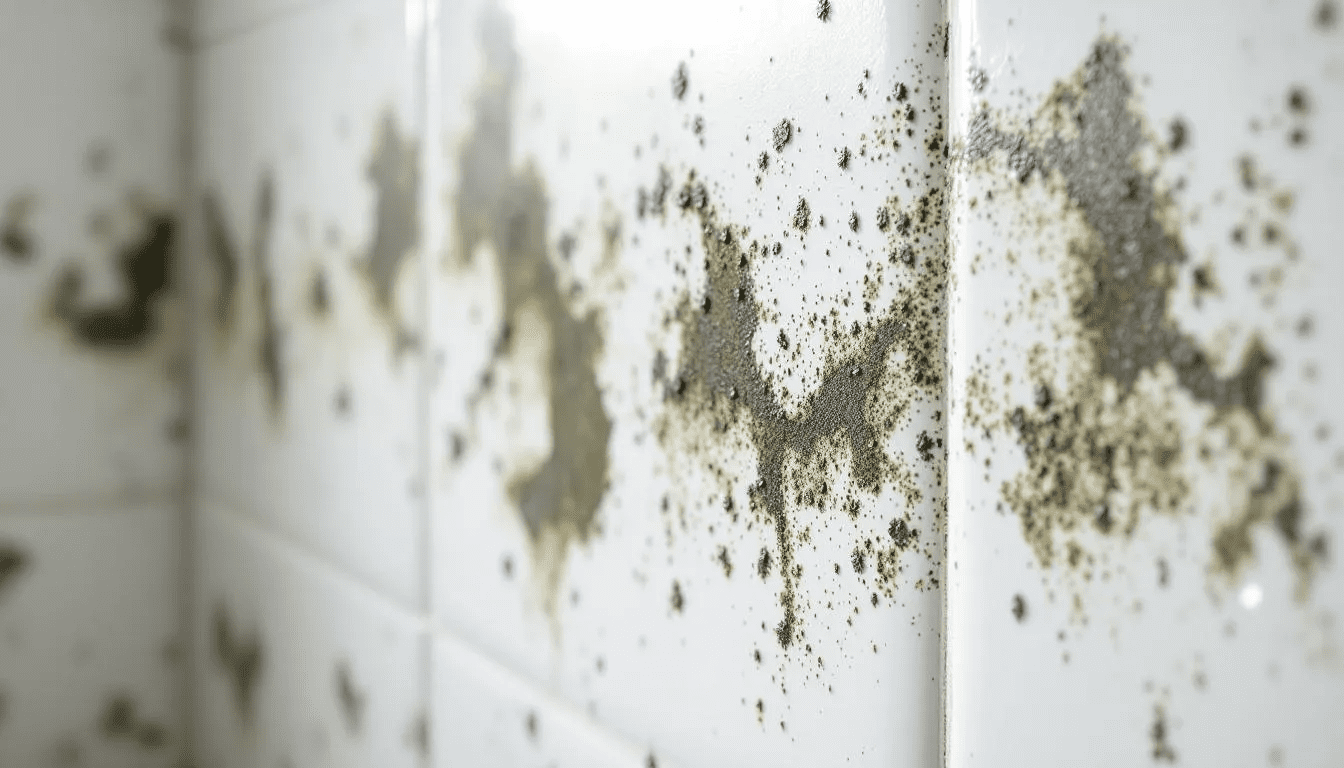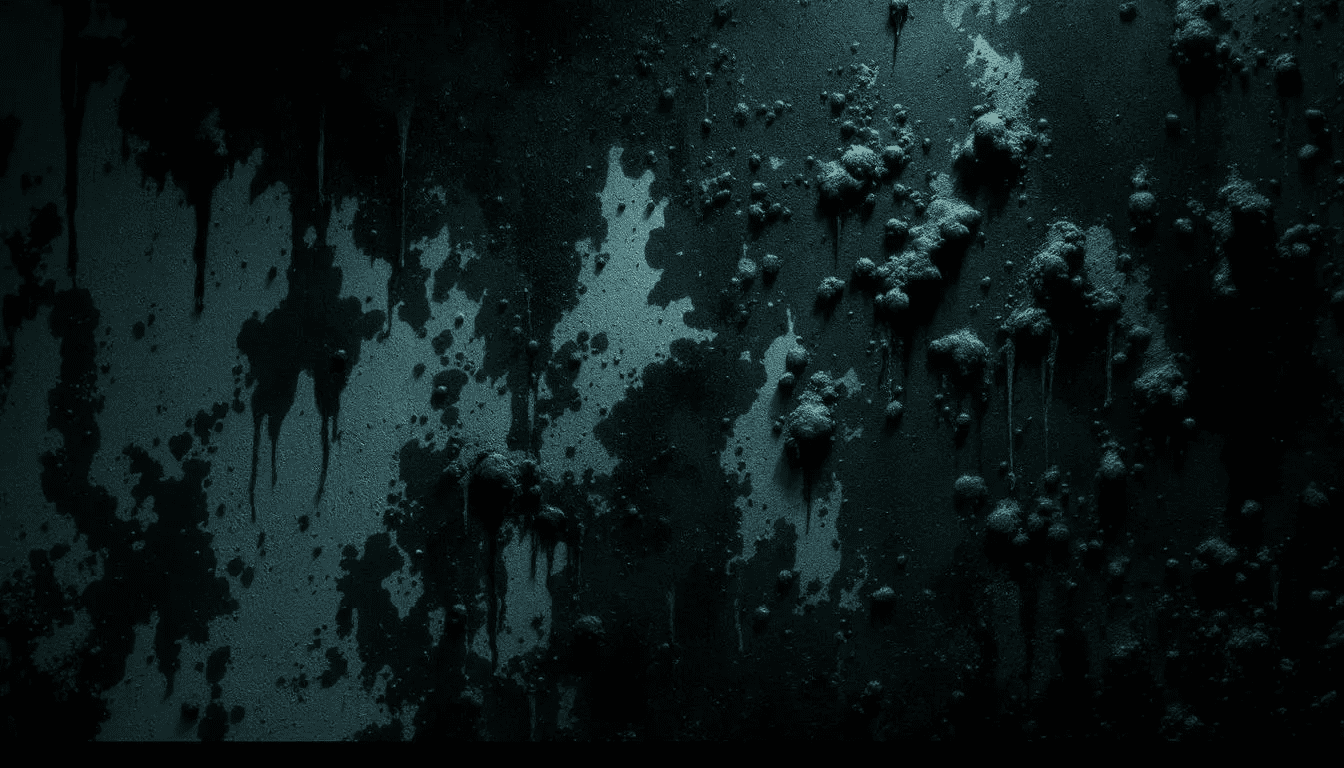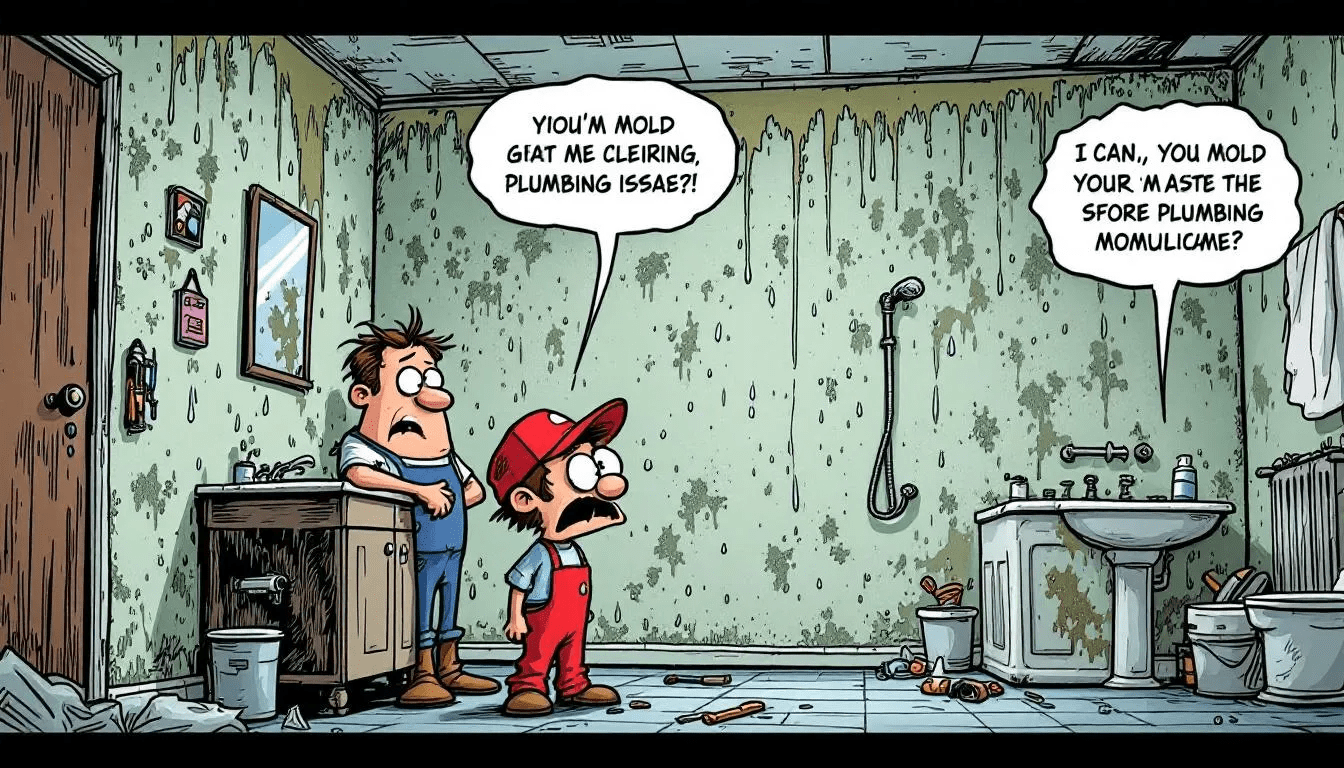Mold in your bathroom is a common problem due to humidity. This guide covers how to identify, remove, and prevent mold remediation in bathroom situations.
Key Takeaways
Mold in bathrooms thrives in warm, moist environments, making early identification crucial to prevent health risks.
Effective mold remediation involves both natural cleaning solutions for small infestations and professional services for larger problems.
Prevention strategies include controlling moisture levels and maintaining a regular cleaning routine to create an inhospitable environment for mold growth.
Identifying Mold in Your Bathroom
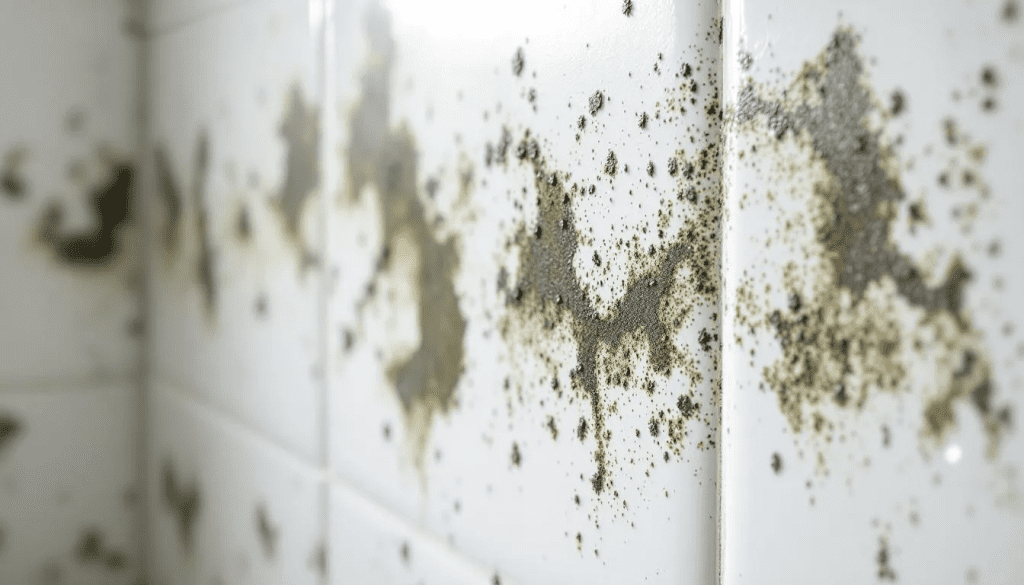
Bathroom mold can be a sneaky intruder, lurking in places you might not immediately think to check. Mold can grow on various materials commonly found in bathrooms, such as:
drywall
wallpaper
paper products
rugs
fabrics
grout
ceiling
tile
wood
bathtub
clothes
The warm, moist, and humid conditions in bathrooms make them ideal environments for mold growth. Mold can also develop behind or above ceiling tiles, drywall, or insulation, and painted surfaces may conceal mold issues. Mold can be found in various rooms, especially those with high humidity, and clothing and other textiles in the bathroom can absorb mold spores.
Common indoor molds include:
Alternaria, which often appears in showers and sinks
Aspergillus
Cladosporium, which can thrive on surfaces such as tubs and under sinks
Penicillium
During a bathroom renovation, most people have even found shower mold growing on the shower curb, highlighting other areas prone to mold growth.
Recognizing mold is the first step in combating it. Look for discoloration on surfaces, a musty odor, or any signs of water damage. Black mold, often considered the most dangerous, is particularly sinister as it can release spores and other compounds that contribute to respiratory irritation. Identifying the mold early allows you to take swift action to remove it and prevent it from spreading.
Effective Mold Remediation Techniques
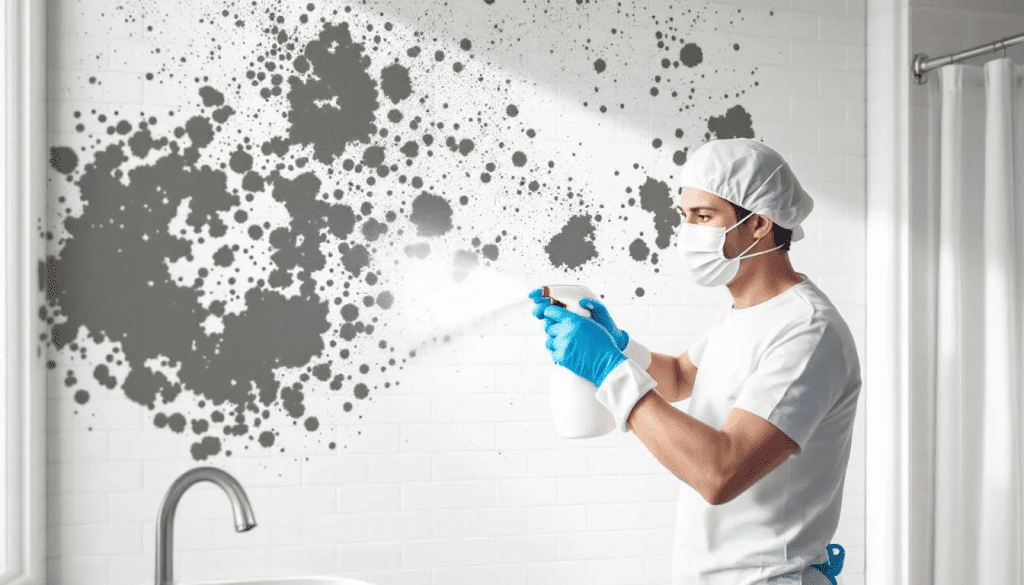
Once you’ve identified mold in your bathroom, the next step is to remove mold. Effective mold remediation techniques are essential to ensure that the mold is not only removed but also prevented from returning. This involves using both natural cleaners and professional mold removal services, depending on the extent of the mold problem. It does not matter what type of mold is present—all mold should be addressed promptly due to potential health risks.
Natural cleaners like white vinegar and hydrogen peroxide are excellent for tackling smaller mold infestations. White vinegar, for instance, can kill over 80% of mold types, making it a safer alternative to harsh chemicals like bleach. Affected surfaces should be thoroughly cleaned to ensure mold is fully removed.
For larger or more hidden mold problems, professional remediation is necessary. Professionals have the expertise and equipment to deal with extensive mold growth, especially when it covers large areas or is hidden within walls or ceilings. In some cases, it may be necessary to replace items like rugs or shower curtains if they cannot be cleaned.
Using Natural Cleaners
Natural cleaning solutions are not only effective but also safer for your health and the environment. White vinegar is a powerful mold killer. Apply undiluted white vinegar directly onto the removal of mold, let it sit for at least an hour, and then scrub the area. This method is effective because vinegar can penetrate porous surfaces, making it ideal for bathroom use.
Hydrogen peroxide is another excellent option to kill mold spores, especially on porous surfaces. You can combine hydrogen peroxide with baking soda to create a paste that helps remove stubborn mold and stains. Simply apply the paste to the moldy area, let it sit for a while, and then scrub it off. This combination is particularly useful for cleaning hard surfaces like tiles and grout.
Mix vinegar with water to clean shower surfaces regularly, preventing mold from re-establishing. Regularly cleaning your bathroom with these natural solutions will help keep mold at bay without exposing you to harsh chemicals.
Professional Mold Removal
Sometimes, the mold problem in your bathroom might be too extensive for DIY solutions. When mold covers an area larger than ten square feet, it is crucial to call professionals for remediation. Professional mold removal is highly advisable for extensive infestations, as they require specialized skills and equipment to be effectively eradicated.
Professionals can handle mold issues that are hidden within walls or ceilings, which would be impossible to tackle with regular household tools. They use advanced equipment to detect and remove all the mold, ensuring that it does not return. This is crucial if the mold is growing in places that are not easily accessible.
Hiring professionals is essential when dealing with severe mold problems. They can provide a thorough cleaning and remediation process, significantly reducing the chances of mold returning. This peace of mind is invaluable, especially if you have vulnerable individuals in your household, such as those with respiratory issues.
Preventing Mold Growth in Bathrooms
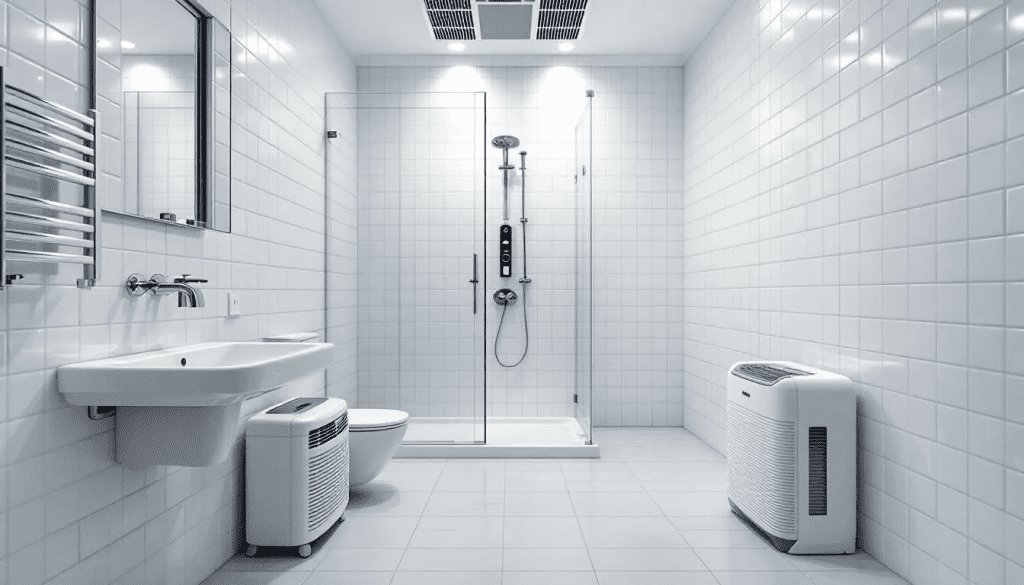
The best way to deal with mold is to prevent it from growing in the first place. Mold thrives in moist environments, so controlling moisture and maintaining cleanliness are crucial strategies to prevent mold growth in bathrooms. Regular cleaning of areas like the tub, shower, and sink can significantly reduce the risk of mold growth.
Controlling moisture and humidity throughout the house, not just the bathroom, is essential for effective mold prevention. Mold can develop in any room with high humidity, and rooms with poor ventilation or poorly insulated walls are especially at risk. Using windows for ventilation and ensuring proper insulation can help manage humidity and prevent mold growth in all areas of your home.
Two key strategies for preventing mold are moisture control and establishing a regular cleaning routine. By implementing these strategies, you can keep your bathroom dry and clean, making it less hospitable for mold spores.
Moisture Control Strategies
Moisture control is the cornerstone of mold prevention. Key points for maintaining low indoor humidity and preventing mold growth include:
Maintaining indoor humidity levels between 30-60%.
Ensuring proper ventilation in the bathroom.
Using exhaust fans during and after showers to reduce moisture accumulation and address any moisture problem.
To reduce humidity in your bathroom, consider the following methods:
Install a high-efficiency bathroom exhaust fan to significantly reduce humidity.
Regularly inspect for and repair leaks to lower moisture levels.
Use a dehumidifier to help manage moisture levels in very humid bathroom environments.
Wiping down wet surfaces immediately after use can significantly reduce small amounts of moisture accumulation and improve air quality. These steps create an environment less conducive to mold growth and more pleasant for daily use, allowing surfaces to dry completely.
Regular Cleaning Routine
Establishing a regular cleaning routine is essential to prevent mold spores from settling in bathrooms. Target areas for cleaning include grout, shower curtains, and other porous materials. Regularly cleaning surfaces such as tiles and bathroom fixtures will significantly reduce mold growth.
Use effective cleaning solutions such as natural cleaners or disinfectants and clean these areas at least once a week. In addition, ensure to check and clean less visible areas, such as behind the toilet and under the sink, to get rid of hidden moisture.
This comprehensive cleaning routine will keep your bathroom mold-free and sanitary.
Maintenance Tips to Avoid Future Mold Issues
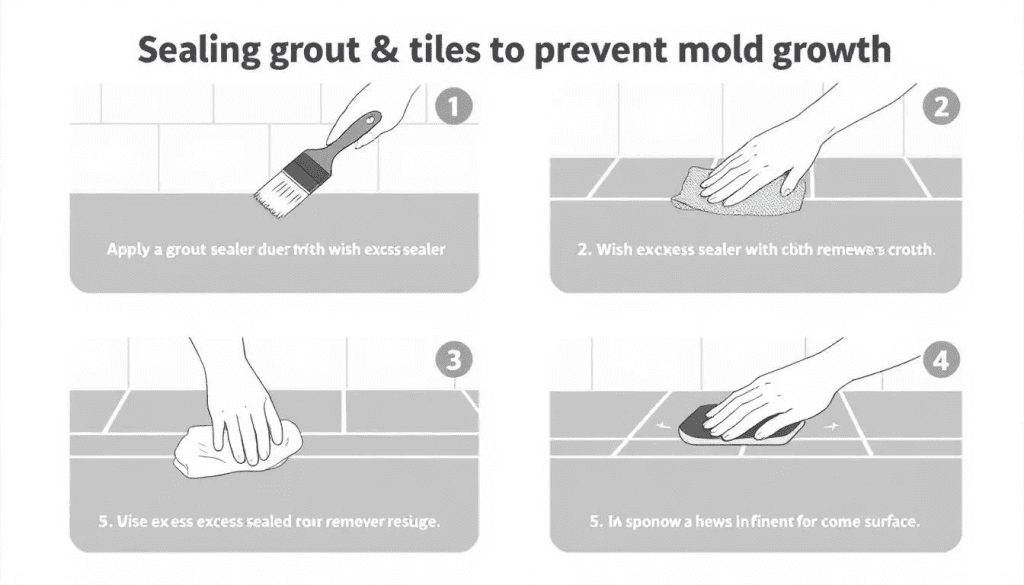
Regular maintenance can significantly reduce the likelihood of mold development in bathrooms. Maintaining low humidity levels is essential to inhibit mold growth. Water droplets left on tiles and other surfaces can contribute to mold growth if not dried promptly, so it’s important to wipe down wet areas after use. Two critical maintenance tips include sealing grout and tiles and choosing the right paint for your bathroom walls.
Following these maintenance tips helps create an environment less conducive to mold growth, ensuring your bathroom remains clean and healthy.
Sealing Grout and Tiles
Sealing grout and tiles is a crucial step in preventing mold because:
Unsealed grout can become porous, leading to absorption of dirt and moisture.
This absorption facilitates mold formation.
Sealing grout creates a protective barrier that prevents moisture from penetrating.
Preventing moisture penetration helps stop mold growth.
Regularly sealing grout lines can significantly reduce moisture absorption and the risk of mold. Sealant applied to grout blocks moisture from penetrating, minimizing mold risk. This is particularly important in areas like shower walls, where water exposure is constant.
Sealing grout and tiles can significantly hinder water from seeping into porous surfaces, which is crucial in preventing mold formation. Regularly sealing grout and caulking prevents water from seeping into cracks, which aids in moisture control. This simple but effective step can make a big difference in your bathroom’s mold prevention efforts.
Choosing the Right Paint
Using mold-resistant paint in bathrooms helps inhibit mold growth on walls. Mold-resistant paint:
Contains agents that inhibit mold growth
Is suitable for high-moisture areas like bathrooms
Can enhance the longevity and cleanliness of bathroom walls by preventing the establishment of mold.
Mold-resistant paint includes fungicides that prevent mold growth, particularly in humid environments like bathrooms. Using fungicide-infused mold-resistant paint can help to prevent mildew and mold spores from establishing on walls. Additionally, a spray application can enhance coverage and effectiveness.
This investment in the right paint can save you a lot of trouble down the line.
Health Risks of Bathroom Mold
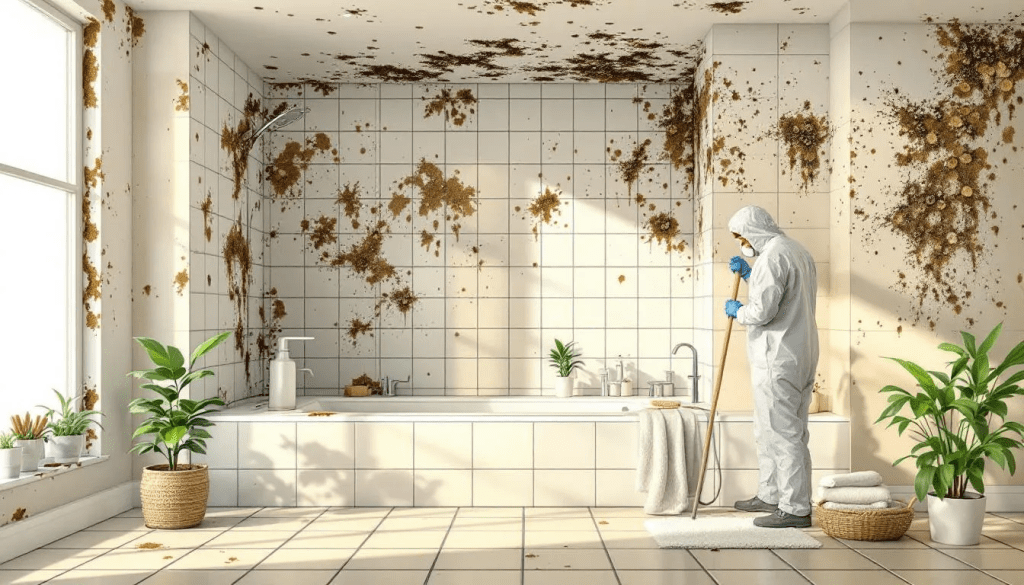
Bathroom mold is not just an aesthetic issue; it can also pose significant health risks. Ulocladium often appears black or brown and can thrive in water-damaged areas, causing respiratory issues in sensitive individuals. Aureobasidium molds, which start off white, pink, or orange, can grow on various bathroom surfaces, potentially leading to irritation in sensitive individuals.
Black mold is notorious for its health risks. It releases spores and microbial volatile organic compounds (mVOCs), contributing to respiratory irritation even in those without mold allergies. Although black mold can cause health issues, it rarely leads to serious illness for most individuals. However, individuals with asthma or weakened immune systems are at a higher risk of experiencing severe reactions to black mold.
Other molds, such as Chaetomium, Aspergillus, Cladosporium, and Penicillium, also pose health risks. Chaetomium requires high moisture levels and can appear in various colors as it matures; it has been linked to serious health issues. Aspergillus molds can grow rapidly in damp areas and may appear in various colors like black, gray, and white.
Cladosporium, recognizable by its olive green or black coloration, can thrive on surfaces such as tubs and under sinks. Penicillium mold, identified by its bluish-green color and fuzzy appearance, can grow on surfaces like window frames and drains in bathrooms.
These health risks underscore the importance of effective mold remediation and prevention. Keeping your bathroom mold-free is not only about maintaining its appearance but also about safeguarding your health.
Summary
In summary, dealing with bathroom mold requires a multifaceted approach. Identifying mold early, using effective remediation techniques, and implementing prevention strategies are crucial steps. Natural cleaners like vinegar and baking soda can be very effective for small mold infestations, while professional help is necessary for larger issues. Moisture control and regular cleaning are key to preventing mold growth, and maintenance tips like sealing grout and using mold-resistant paint can help avoid future problems.
Remember, a mold-free bathroom is not just about aesthetics; it’s also about maintaining a healthy living environment. By following these tips, you can ensure that your bathroom remains a clean, safe space for you and your family. Take action today to keep mold at bay and enjoy a healthier home.
Frequently Asked Questions
What are the common types of mold found in bathrooms?
The common types of mold found in bathrooms are Alternaria, Aspergillus, Cladosporium, and Penicillium. It’s important to address these molds promptly to maintain a healthy environment.
How can I use natural cleaners to remove mold in my bathroom?
To effectively remove mold in your bathroom, use undiluted white vinegar for application, and create a paste with hydrogen peroxide and baking soda to scrub the affected areas. This combination is a powerful natural solution for mold removal.
When should I hire professionals for mold removal?
You should hire professionals for mold removal if the affected area exceeds ten square feet or if the mold is hidden within walls or ceilings. This ensures proper remediation and safety.
How can I prevent mold growth in my bathroom?
To prevent mold growth in your bathroom, control moisture by keeping humidity levels low, using exhaust fans, wiping down wet surfaces, and maintaining a regular cleaning routine. Consistent attention to these practices will help create a mold-free environment.
What health risks are associated with bathroom mold?
Bathroom mold poses significant health risks such as respiratory issues, allergic reactions, and irritation, particularly for sensitive individuals or those with weakened immune systems. It’s crucial to address mold growth promptly to protect your health.

